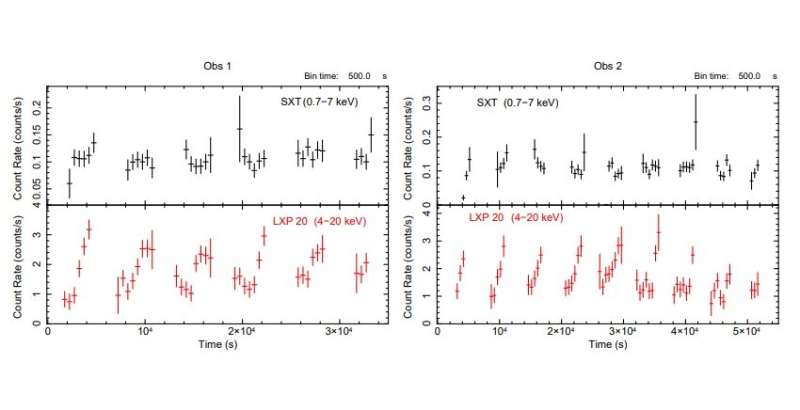February 9, 2021 report
Galaxy Mrk 335 examined with AstroSat

Using the AstroSat spacecraft, Indian astronomers have performed multiwavelength observations of a Narrow-Line Seyfert 1 (NLS1) galaxy known as Mrk 335. Results of this investigation, presented in a paper published February 1 on the arXiv preprint server, deliver crucial information about the emission from this source.
Narrow-line Seyfert 1 (NLS1) galaxies are a class of active galactic nuclei (AGN) that have all the properties of type 1 Seyfert galaxies, but show peculiar characteristics like narrow Balmer lines, strong Fe II emission, and extreme properties in the X-rays.
At a redshift of 0.026, Mrk 335 is an NLS1 galaxy exhibiting dramatic fluctuations between high and low flux states in the X-ray band. Previous studies of this galaxy have found that it showcases considerable variability in the optical and ultraviolet (UV) bands that appears to be correlated and uncorrelated with the X-ray variability at various epochs.
In order to get more insights into this variability, a team of astronomers from the Inter-University Centre for Astronomy and Astrophysics in India, led by Savithri H. Ezhikode, has conducted multiwavelength observations of Mrk 335 with AstroSat in X-ray and UV bands.
"Mrk 335 was observed simultaneously in the X-ray and UV bands with Soft X-ray Telescope, Large Area X-ray Proportional Counter (LAXPC), Cadmium Zinc Telluride Imager (CZTI), and Ultraviolet Imaging Telescope (UVIT) aboard AstroSat on October 31, 2017 (Obs 1) and November 18, 2017 (Obs 2)," the researchers wrote in the paper.
During AstroSat observations, Mrk 335 turned out to be in a low-flux state in X-rays and in the UV band, and the X-ray spectra were found to be harder than usual. The monitoring identified variability in both near-UV (NUV) and far (UV) FUV emissions, but no significant variability was found between the two performed X-ray observations.
Both Obs1 and Obs2 were found to be intrinsically absorbed with photon index at a level of approximately 9.0 sextillion cm-2. The total flux in the 2–20 keV is roughly 0.02 nanoerg/cm2/s, and in the 0.7–2 keV band it is some 0.0006 nanoerg/cm2/s.
The UV flux was found to be variable between Obs 1 and Obs 2. The astronomers assume that X-ray reprocessing or the obscuration of X-rays by clouds could be the origin of the observed UV variability. However, more studies of Mrk 335, including detailed modeling of the broadband spectral energy distribution (SED) are needed in order to find out which scenario is true.
"A more detailed characterisation of broadband X-ray continuum emissions may be carried out with future better observations with AstroSat. With simultaneous filter and grating observations with UVIT, we can also study the nature of variability in the accretion disc emission in depth," the authors of the paper explained.
More information: AstroSat view of the NLS1 galaxy Mrk 335, arXiv:2102.00805 [astro-ph.HE] arxiv.org/abs/2102.00805
© 2021 Science X Network





















